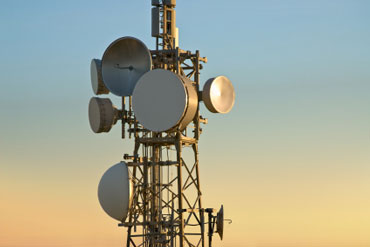February 15, 2013
What does the future of wireless technology look like? One of the trends that is emerging and will have an impact on wireless point to point systems is small cell architecture. A major factor behind this trend is the ever growing demand for bandwidth driven by 4G technology. When 4G capabilities are added to today's urban 2G/3G networks or are rolled out as green-field deployments, cell site backhaul and aggregation network requirements will rise from the tens and hundreds of megabits/second into the gigabits/second of capacity range. As more people use mobile devices and more applications are available, new ways of meeting this demand are required. Small cell architecture and higher capacity backhaul wireless systems will provide the technology to meet this demand.
A small cell is generally defined as a low power device that operates on licensed frequencies, and functions as small, self-contained cellular base station. There are at least three major components to this architecture and these include femtocells, picocells and metrocells.
Femtocells are devices such as distributed antenna systems that can improve the quality of cellular voice service - primarily from the standpoint of creating or improving coverage inside a small business or home.
A picocell is a larger femtocell that is deployed into a business or small venue. The typical picocell is physically larger than a femtocell, has a higher power output (between 100 to 150 milliwatts) and, consequently, has a longer range and the ability to support a larger area, traffic capacity and/or more concurrent users.
Metrocells are low power cell sites that operate on an operator's licensed frequency to provide additional coverage and/or capacity in a given area. There are three types of metrocells: those that operate on 3G only, 4G only, and those that can operate on both.
To support this architecture the Carrier's backhaul capabilities will have to grow to meet the projected increases in traffic. Wireless backhaul refers to a high speed broadband transmission medium carrying data across two end nodes (e.g., from an access network to the core network operations center) using high-performance Point-to-Point wireless links. A typical wireless backhaul scenario consists of endpoint pairs communicating via a wireless link which carries high-bandwidth, time-sensitive data in a highly secure manner.
Low cell-site fiber penetration rates, coupled with often prohibitive costs of new fiber lateral deployment, will drive the adoption of "wireless fiber" high-capacity microwave and millimeter wave solutions as a technology upgrade for copper based services. Unlike copper circuits and leased fiber services, high-capacity uWave and millimeter wave solutions scale in performance up to the multi-gigabit performance range, without incurring a corresponding increase in operator costs.
These solutions provide highly-available connectivity at typical urban and medium-range backhaul distances and feature sufficient capacity to simultaneously support legacy TDM and rapidly-growing IP packet traffic. With worldwide adoption of the 80 GHz spectrum band underway, 80 GHz links are well-positioned to fulfill a critical enabling role for emerging 4G mobile deployments.
Wireless backhaul systems will have to be high capacity - 1Gigabit+, highly reliable and secure, and relatively low cost. Small beamwidths, adaptive modulation, and licensed bands will also be key features of these products. The latest generation of these products are expected to be available later this year.
Direct Network Services has the RF expertise and experience in working with the types of systems that will be needed to support small cell architecture. For more information about how we can support your wireless requirements contact us at 978-952-6000 or email us at sales@directnetserv.com.
